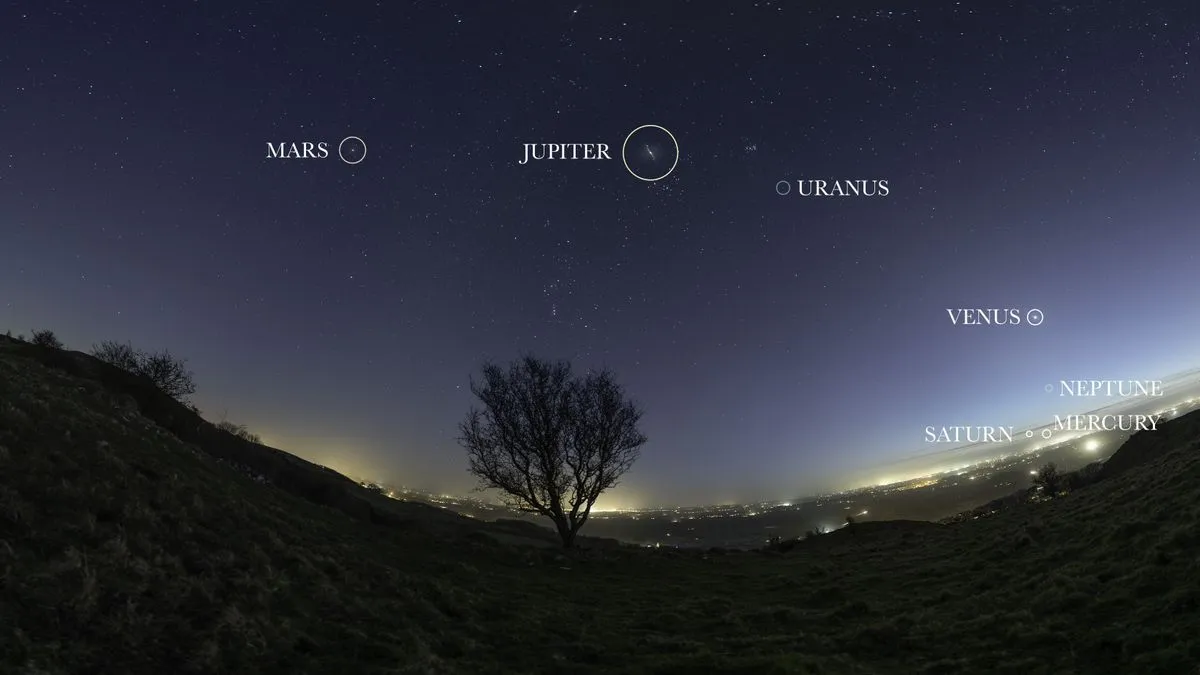
A breathtaking photograph has captured a rare moment in the night sky—all seven of our neighboring planets visible from Earth simultaneously. This stunning composite image, taken by the talented astrophotographer Josh Dury, showcases the planets Mars, Jupiter, Uranus, Saturn, Venus, Neptune, and Mercury in perfect alignment, thanks to a rare planetary parade occurring this weekend, marking the first of its kind since 1982.
While spacecraft like NASA's Voyager 1 have previously captured images of all the planets from space, advancements in terrestrial photography have only recently made it possible to photograph them from the ground. Dury's remarkable photo is likely the first of its kind, showcasing seven planets in one frame. In an email to Live Science, Dury mentioned, "Seven (arguably, 8) is a feat that to my prior knowledge has not been achieved before." By including Earth, which is visible in the foreground, the total number of planets in the image rises to eight, potentially making this photograph a historic achievement.
Dury captured this extraordinary image just after sundown on February 22 from The Mendip Hills, a stunning range of limestone hills located in Somerset, U.K. The image serves as a record of the first opportunity to glimpse the planets as light from the sun diminished, making them more visible against the evening sky. To achieve this photographic marvel, Dury created a composite shot made up of multiple panes, each captured through several exposures.
To locate the dimmer planets Saturn, Neptune, and Mercury, which were closer to the western horizon, Dury utilized astronomy software to generate models of the night sky. This allowed him to match the planetary locations with nearby star fields. Using a high dynamic range (HDR) camera setting, he successfully captured the faint light of the planets. Dury commented on the challenges he faced, stating, "It would not, of course, be possible to photograph the lowest planets at the moment of sunset—glare from the sun rendering this task impossible." Thus, this photograph represents the first possible glimpse of the planets as the sun's light faded away.
Planetary conjunctions occur when two or more planets appear close together in the sky, although this alignment is merely a result of our perspective from Earth. In reality, these planets remain extremely far apart in space. While conjunctions are not uncommon, the frequency decreases as more planets are added to the alignment. For instance, the three innermost planets—Mercury, Venus, and Earth—align within 3.6 degrees every 39.6 years. However, for all eight planets in our solar system to align closely, it would take an astounding 396 billion years, a phenomenon that will not occur before the sun transforms into a red giant, likely consuming Mercury, Venus, and possibly Earth in the process.
While the alignment of all eight planets is a distant possibility, it is somewhat less unusual for all seven planets to be positioned on the same side of the sun, as shown in Dury's image. Enthusiasts can look forward to another seven-planet parade visible from Earth in 2040, making it a thrilling time for astronomy lovers and skywatchers alike.